Mold on Concrete
Have you ever looked at your basement foundation walls and notice something growing on it? If so, you are not alone. This could be something hazardous, or it could be harmless.
We will look at what is growing and how to remove it correctly, not harm your dwelling or regrow after it has been removed. If you see something like mold on concrete, contact Mold Busters right away to get it professionally tested to ensure it is safe.
Worried About Mold on Concrete? Get a Free Inspection!
Mold on concrete can be tricky to detect and hazardous to your health. Don’t let it go unchecked! Contact Mold Busters for a free virtual mold inspection. Our experts will provide a comprehensive assessment and plan to tackle any mold issue, ensuring your home is safe and healthy. Act now to protect your space!
Contents
- Does mold grow on concrete?
- What causes mold on concrete?
- Signs of mold on concrete?
- What does mold on concrete look like?
- Understanding concrete and mold Growth
- Common places for mold growth
- Types of mold on concrete
- Is mold on concrete dangerous?
- How to identify mold on concrete?
- How to prevent mold on concrete?
- How to remove mold on concrete?
- Frequently asked questions
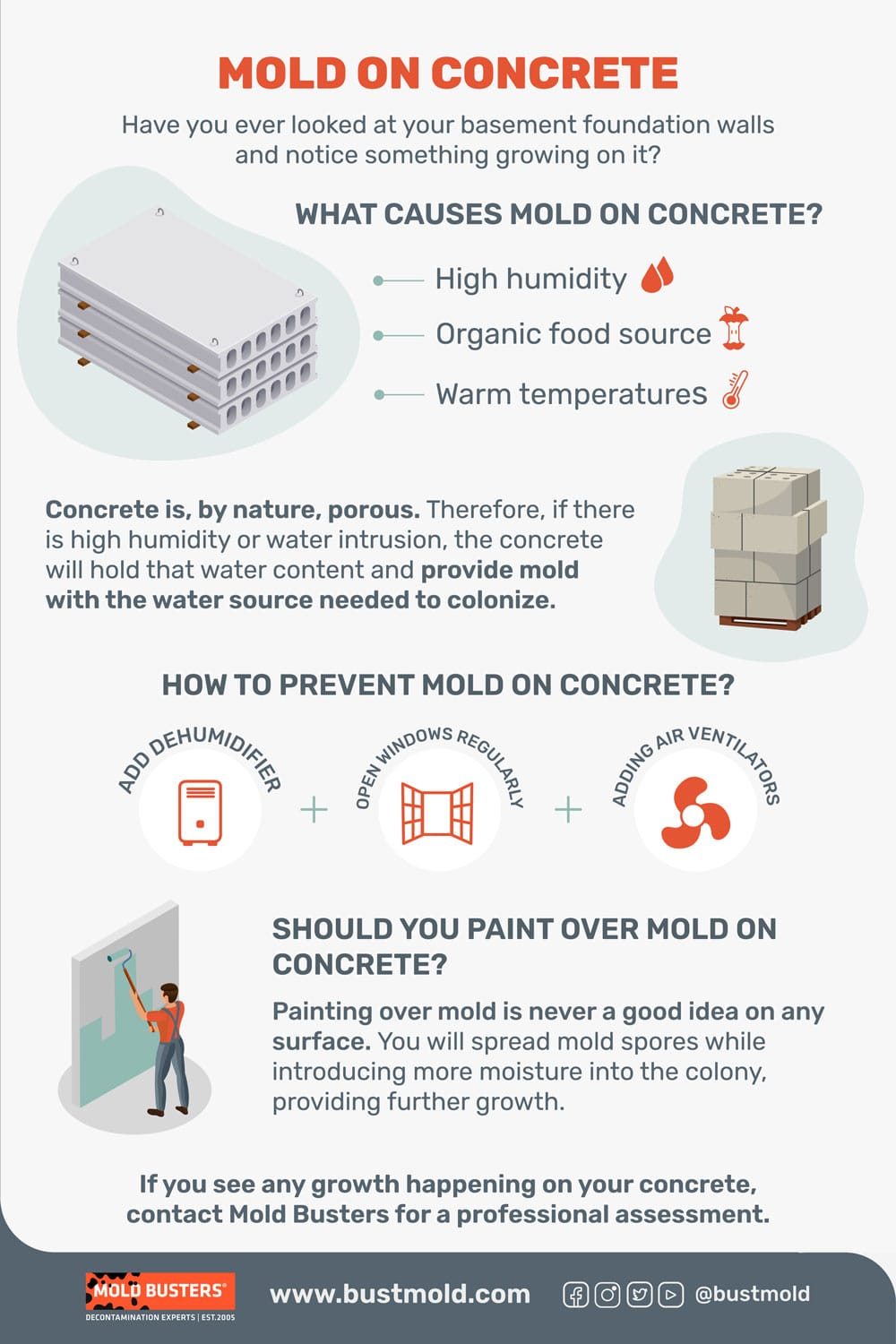
Does mold grow on concrete?
Mold's ability to grow on various surfaces often raises questions about its presence on concrete. The simple answer is yes. Concrete, due to its porous nature, can harbor mold when conditions are right. Especially in places where moisture meets organic material, concrete becomes a prime spot for mold growth.
What causes mold on concrete?
Mold needs three things to survive and thrive:
- Mold needs an organic food source to grow and multiply
- It needs the correct environmental temperature to colonize and expand
- Finally, mold needs a damp, wet environment to survive.
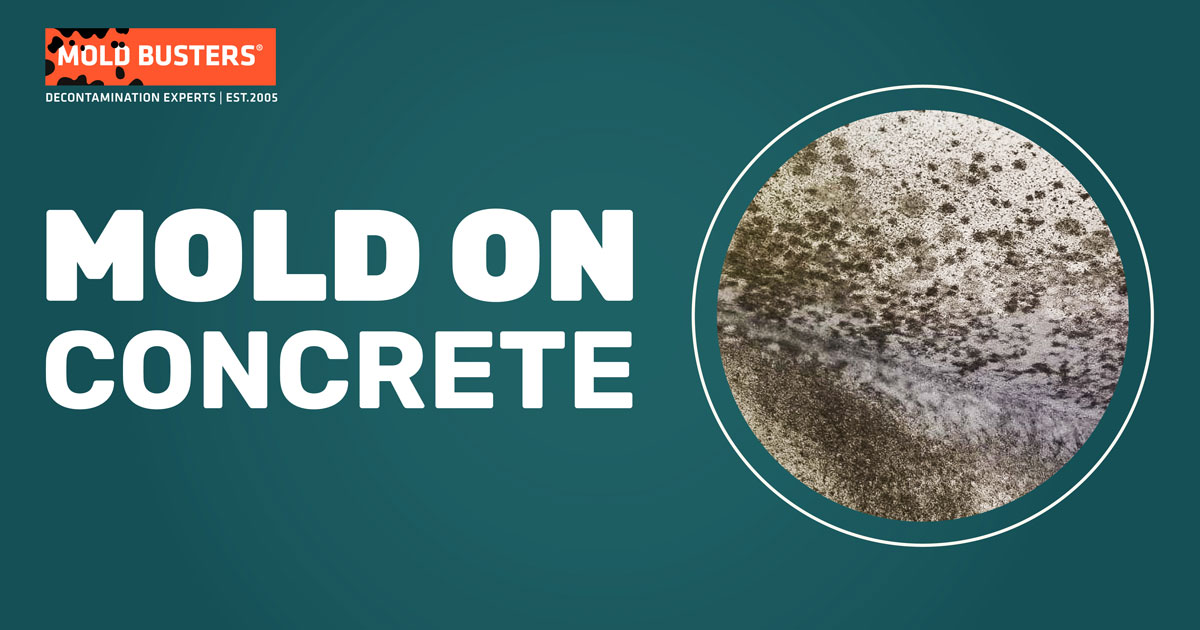
Concrete is, by nature, porous. Therefore, if there is high humidity or water intrusion, the concrete will hold that water content and provide mold with the water source needed to colonize.
It would be best if you always kept your basements dry by using a dehumidifier and keeping temperatures elevated. If there is water pooling outside around your foundations, you may have a drainage issue causing water to creep inside and provide a water source for the mold colony.
Signs of mold on concrete?
To know if you have mold growth on your concrete, you can first see what the “growth” looks like. Sometimes, a reaction with water and concrete creates the mineral growth called efflorescence. This can look like a white mold type growth coming out of your concrete structures.
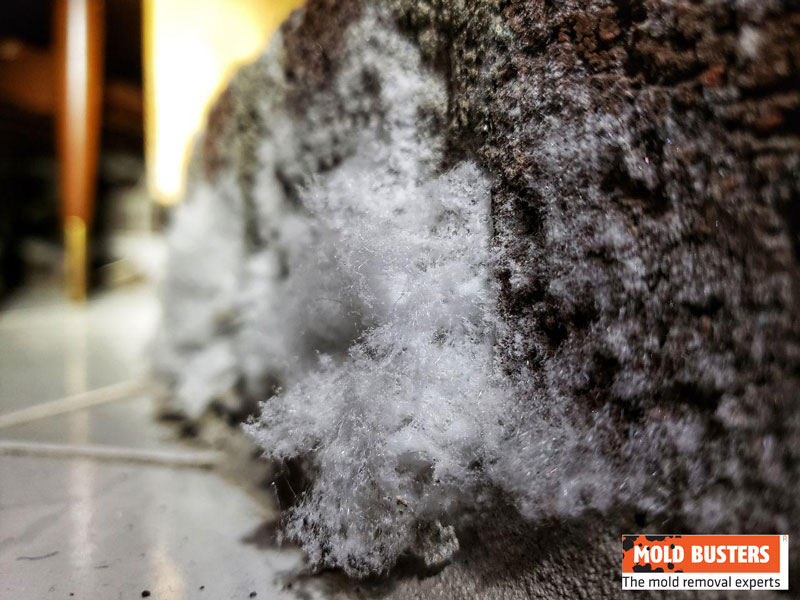
If you see any growth happening on your concrete, contact Mold Busters to have a professional inspector visit your location and test the affected area to see if you have mold or not.
If the growth is brown, green, or black, the chances are that it is some mold colony growing on your concrete surfaces. At this point, you should not touch the affected area as mold spores are highly transportable via air currents. If you even walk by a mold colony, you could spread it to other areas of your home.

Did you know?
Chaetomium is the 2nd common toxic mold type found in homes we tested?! Find out more exciting mold stats and facts inside our mold statistics page.
What does mold on concrete look like?
Mold on concrete can look like any number of different things. It depends on what classification of mold is growing on the surface of your concrete. It could be white, black or green.
Mold can be harmless or harmful regardless of color, so you should have a professional from Mold Busters visit your property for an expert inspection.
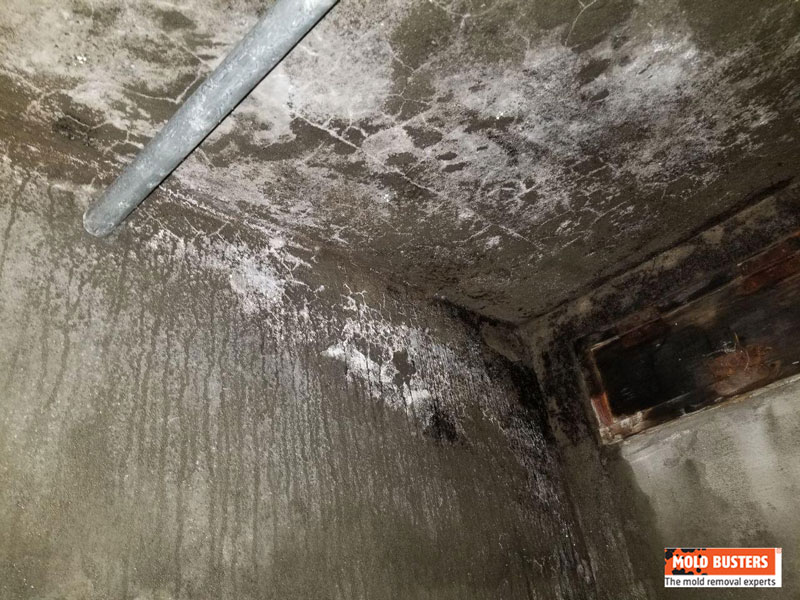
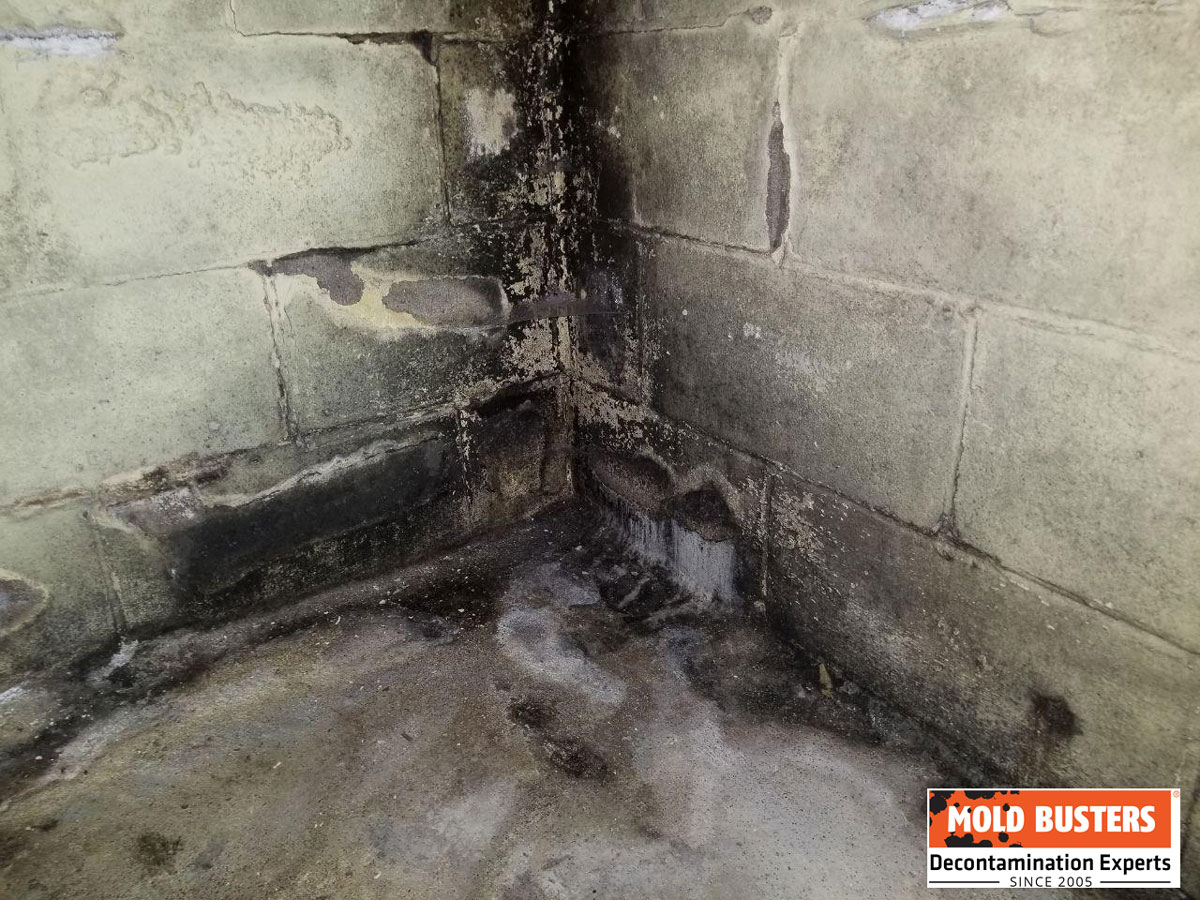
If you mistake black mold for mildew and try to clean it off, you could spread it to the rest of your home. Certain black molds grow in circular formations and are easy to spot; however, this is not always the case.
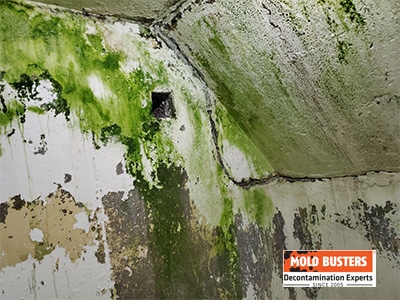
This mold should be treated in the same way as any mold colony growing inside your home.
Understanding concrete and mold Growth
Concrete, a mixture of cement, water, and aggregate, might seem impervious to something like mold. However, its very nature can make it susceptible. Here’s a breakdown of common locations and the reasons mold might thrive there.
| Location | Reason for Mold Growth | Prevention Tips |
|---|---|---|
| Concrete Floors | Pooling water, consistent moisture | Ensure proper drainage, use dehumidifiers |
| Concrete Walls | Lack of ventilation, consistent moisture | Install vents, check for leaks |
| Basement Walls | High humidity, water leaks | Waterproofing, inspect regularly |
| Outdoor Concrete | Prolonged dampness, lack of sunlight | Ensure sunlight exposure, clean regularly |
Cement mold & can mold grow on cement?
Cement, a primary component of concrete, is naturally porous. This means that mold can grow on cement surfaces, especially when they’re exposed to moisture and organic substances..
Concrete slabs and mold
Concrete slabs, especially those located outdoors like patios, can develop mold when they’re exposed to wet conditions and lack proper drainage.
Common places for mold growth
Mold doesn't discriminate. Whether it's a floor, wall, or basement, if the conditions are right, mold will find its way.
Mold on concrete floor
Mold can grow on concrete floors, especially in damp areas like basements. It’s essential to keep floors dry and clean to prevent mold growth.
Mold on concrete wall
Concrete walls, especially in basements, can become breeding grounds for mold if they’re exposed to moisture and lack proper ventilation.
Mold on basement walls
Basements are particularly susceptible to mold growth due to their location and the potential for ground water intrusion. Using a sump pump or an interior footing drain can help manage water in basements.
Types of mold on concrete
To better understand the various types of mold that can grow on concrete, here’s a comprehensive table detailing their characteristics and potential risks.
| Mold Type | Color | Appearance | Potential Risks | Common Locations |
|---|---|---|---|---|
| Black Mold | Black | Dark spots or patches | Health concerns due to toxins | Basements, damp walls |
| White Mold | White | Powdery, fluffy, or crystalline | Can be mistaken for efflorescence | Concrete floors, walls |
| Green Mold | Green | Plant-like or mossy | Mild to moderate health concerns | Outdoor concrete, shaded areas |
| Brown Mold | Brown | Earthy patches | Mild health concerns | Often in basements or garages |
Black mold on concrete
One of the most notorious types, black mold, scientifically known as Stachybotrys chartarum, often appears as dark spots. Its presence can be alarming due to the health risks associated with it. If you notice black mold, it's crucial to address it promptly.
Is black mold on concrete dangerous?
Yes, black mold on concrete can be hazardous. Prolonged exposure can lead to respiratory issues, allergies, and other health problems.
White and mold on conrete
White mold on concrete often appears as a powdery, fibrous substance. It can sometimes be mistaken for efflorescence, a crystalline growth that can look like mold.
Green mold on conrete
Green mold is another common type that can grow on concrete. It might not always look as “plant-like” as algae or moss but should be treated with the same caution.
Is mold on concrete dangerous?
As with any mold, mold on concrete can be dangerous to your health. If the mold colony is growing inside your home, professional remediation needs to be performed as not to spread the mold spores to other places in the home.
The risks of having mold growing on your concrete surfaces are twofold. The first risk of having mold in your building or home is health concerns. Mold causes a variety of sicknesses and illnesses if you come in contact with it. Therefore, having it removed the correct way is essential to the health of your dwelling.
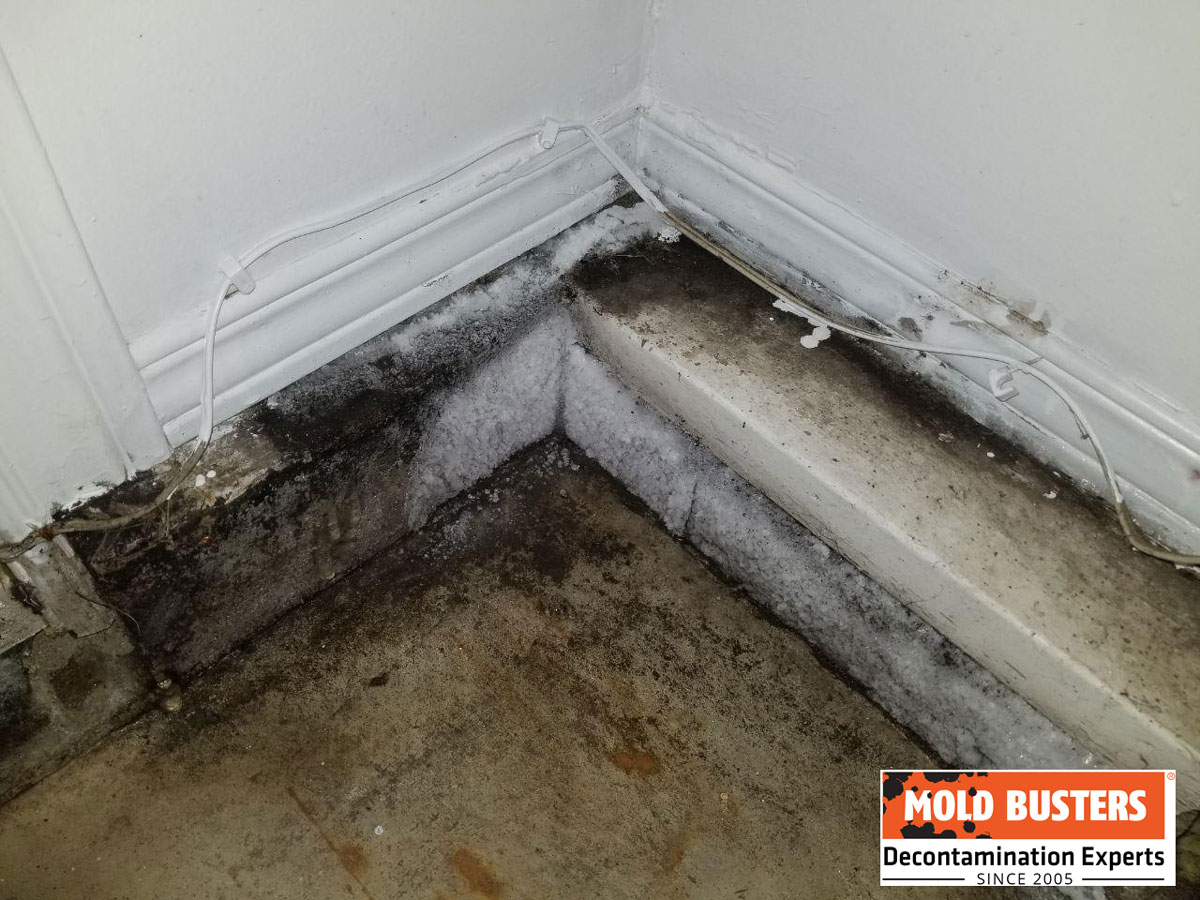
Mold Busters will provide all of your needed inspection and remediation services to ensure that your home is 100 percent safe while the remediation is being completed.
How to identify mold on concrete?
If you think you have mold growing on your concrete surfaces, you can look at few things to see if it is indeed mold.
Color of the growth pattern. If it is white, black, brown, or green, it could be a mold colony growing on your surfaces.
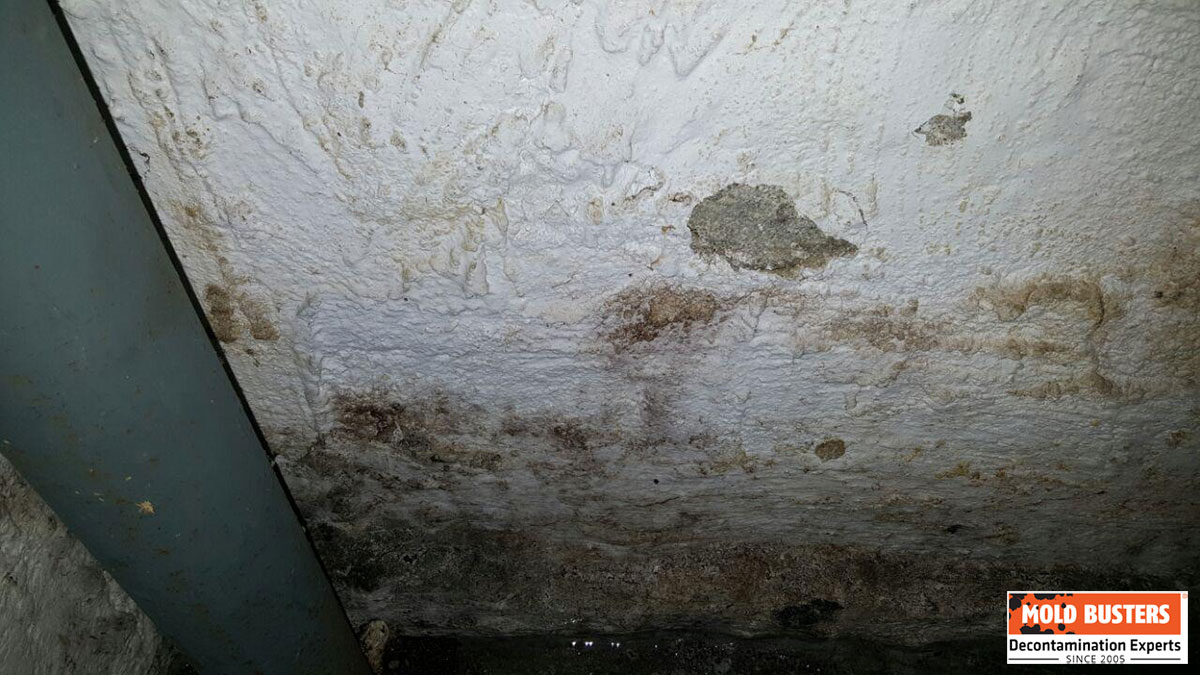
The shape of the growth. Are there circular patterns? What about a “climbing” growth pattern from the floor up the wall? If so, this is a good indication of a mold colony growing on the concrete surfaces.
If you see any stains, growth patterns, or other concerning objects growing on your concrete walls, contact a professional at Mold Busters and have a complete inspection done to confirm the growth is, in fact, mold. If you’re in the Montreal or Ottawa area, our teams are ready to assist you with comprehensive mold inspection and removal services.
How to prevent mold on concrete?
As mentioned earlier, mold needs three conditions to thrive:
- Water source
- Food source, and
- Proper temperature.
If you remove one or more of those, you stop the mold from growing.
Prevention is always better than cure. Here’s a table detailing various preventive and treatment measures for mold on concrete, along with their effectiveness.
| Action | Method | Effectiveness | Additional Notes |
|---|---|---|---|
| Ventilation | Install fans or vents | High | Essential for basements and enclosed spaces |
| Use of Dehumidifiers | Place in damp areas | High | Regularly empty and clean |
| Regular Inspection | Check for water leaks, mold spots | Moderate to High | Especially after rains or plumbing issues |
| Mold-Resistant Paints | Apply on concrete surfaces | Moderate | Reapply as per manufacturer's recommendation |
To keep your basement safe, you can do some easy steps to ensure your home is mold-free. First, make sure you have a dehumidifier and it is operating correctly. A dry basement is a healthy basement. Keep the temperature a little warmer in the basement since relative humidity (RH) decreases as temperature increases.
Keep your basement clean and clear of unnecessary organic materials like dirt, old newspapers, and other items like that. If you need to keep things, make sure they are in a storage container to keep them and your basement safe.
Additional tips
- Fungal growth: Apart from mold, other types of fungal growth can appear on concrete. It’s essential to identify the type of growth correctly to treat it effectively.
- Excess moisture: Excess moisture is the primary cause of mold growth. Ensure proper drainage, fix leaks, and use tools like sump pumps and French drains to manage water.
- Poor ventilation: Areas with poor ventilation, like basements, are more prone to mold growth. Ensure adequate airflow and consider using fans or dehumidifiers.
How to remove mold on concrete?
The answer to this question is straightforward. It would be best if you did not touch mold growing in your home by yourself. It needs to be remediated by a professional, who are appropriately trained and certified to inspect and remediate any mold in your home.
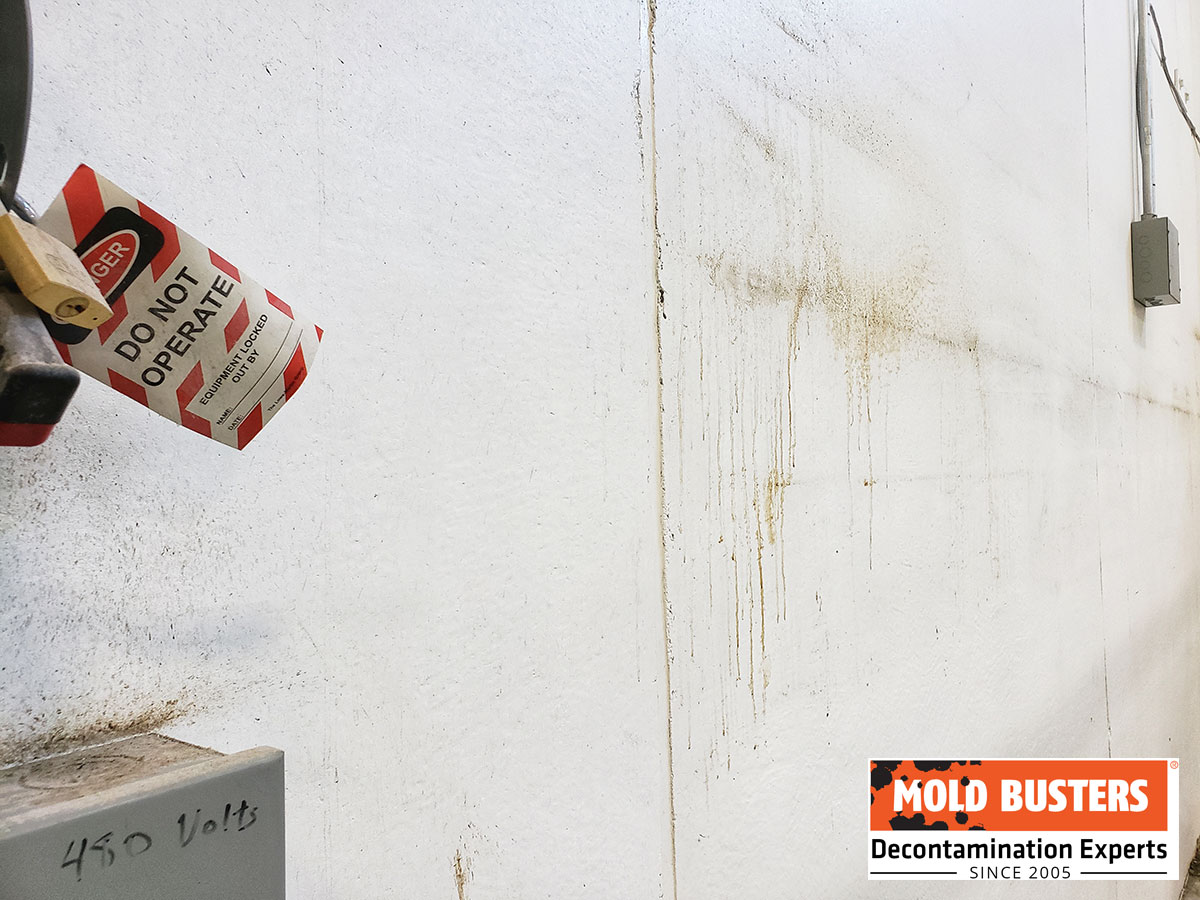
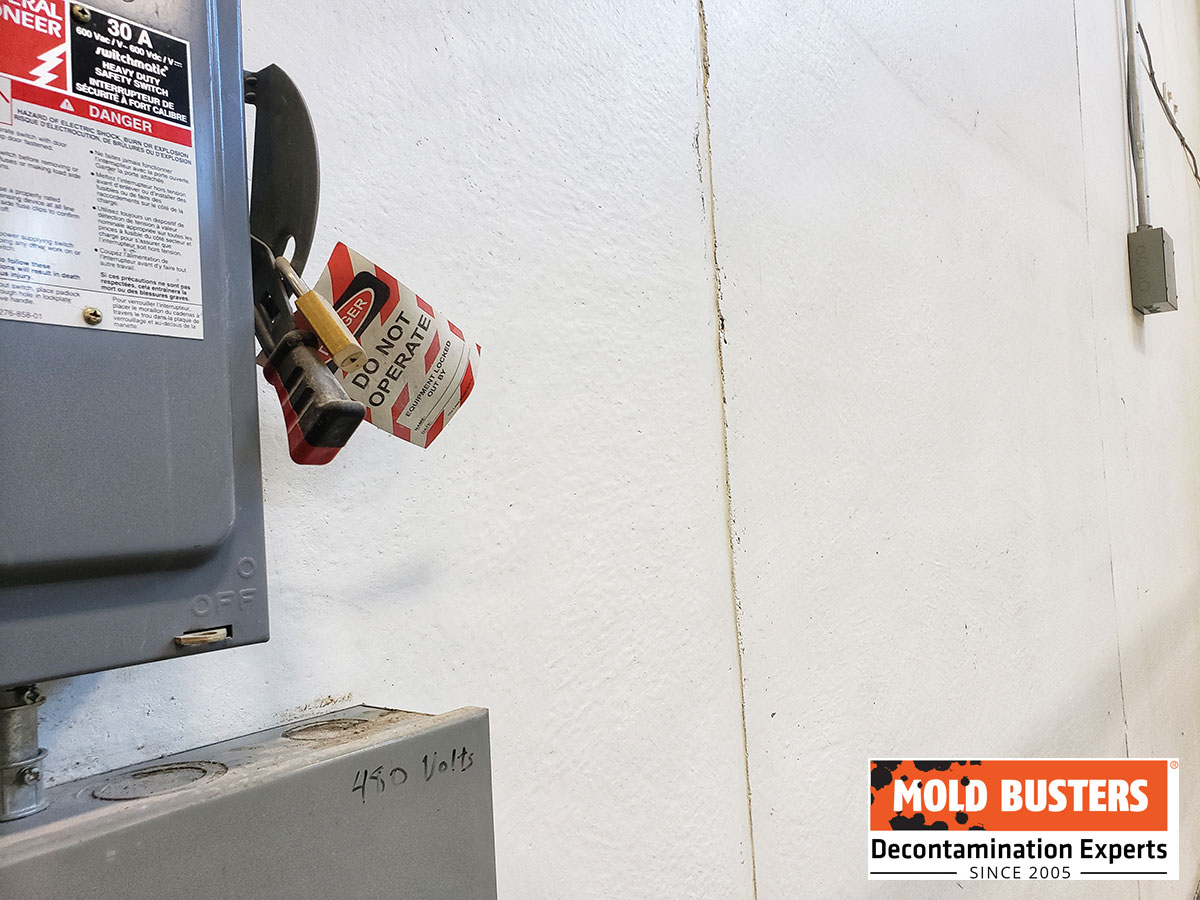
To properly remove mold, you need to have a full containment created so that the spores do not travel to other home areas. Furthermore, it would be best if you had complete personal protective equipment (PPE) as well. Failure to do either of these will compromise the health of your home, as well as yourself.
Leave it to the professionals at Mold Busters, and feel safe that your home is in the right hands to diagnose and remediate the mold growing in your home. If you’re unable to have an in-person inspection, we also offer a free virtual mold inspection service to help identify potential mold issues.
Frequently asked questions
Will bleach or vinegar kill mold on concrete?
Technically, yes. Bleach or vinegar can kill the mold organism. However, it’s not enough to kill it. It needs to be removed from your home. Just washing the area with a solution does not effectively do the right job.
The dead mold spores can still cause sicknesses, and while trying to clean the mold with solution, you can spread spores to other areas before they are killed, causing more colonies to form. Remediation by a Mold Busters professional team is the correct way to remove and kill mold in your home.
Should you paint over mold on concrete?
Painting over mold is never a good idea on any surface. You will spread mold spores while introducing more moisture into the colony, providing further growth. It will look as if it was covered for a few days, and afterward, it will return to an area bigger than before it was painted. Remediation is the correct way to get rid of mold on concrete.
How can I prevent mold growth on concrete surfaces?
To prevent mold growth on concrete surfaces, it’s essential to control excess moisture. Ensure proper ventilation, especially in basements, use dehumidifiers, and address any water leaks promptly. Regularly inspecting outdoor concrete, like patios, for water pooling and ensuring good drainage can also help.
Is wet concrete more susceptible to mold growth?
Yes, wet concrete can be more susceptible to mold growth. Concrete is porous, and when it remains wet or damp, it can provide the ideal conditions for mold to thrive, especially if there’s organic material present. It’s crucial to let concrete slabs dry thoroughly after construction or cleaning to prevent mold.
Can mold-resistant paint help in preventing mold on concrete surfaces?
Absolutely! Mold-resistant paint can act as a barrier, preventing mold spores from settling and growing on concrete surfaces. It’s especially beneficial in areas prone to dampness, like basement walls. However, it’s essential to clean and remove any existing mold before painting.
What’s the best way to clean mold from a concrete surface?
For minor mold issues, a cleaning solution of bleach or mold-killing detergent diluted in water can be effective. Use a scrub brush and some elbow grease to scrub the mold off the surface. Always wear protective gear, like rubber gloves and a mask, during the cleaning process. For more extensive mold problems, consider professional mold removal services.
Are there health hazards associated with mold on concrete?
Yes, mold, regardless of where it grows, can pose potential health hazards. Some people might experience allergic reactions, respiratory issues, or other health problems when exposed to mold. It’s especially concerning if mold grows in living spaces, as spores can become airborne and inhaled.

Get Special Gift: Industry-Standard Mold Removal Guidelines
Download the industry-standard guidelines that Mold Busters use in their own mold removal services, including news, tips and special offers:
"*" indicates required fields
Published: August 9, 2021 Updated: June 12, 2024

Written by:
Steven Adams
AMRT, WRT, ASD
Mold Busters
Fact checked by:
Michael Golubev
CEO
Mold Busters
